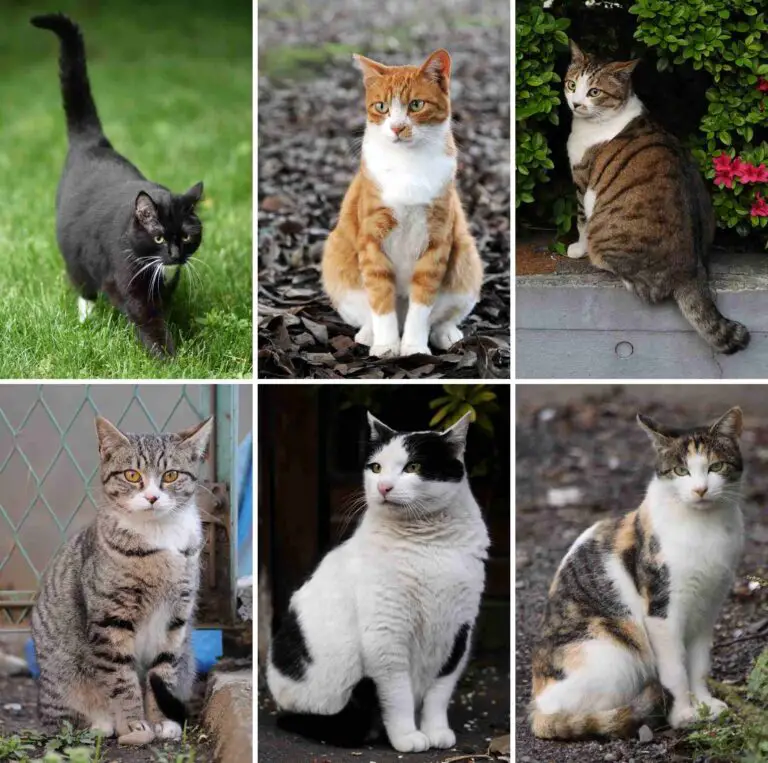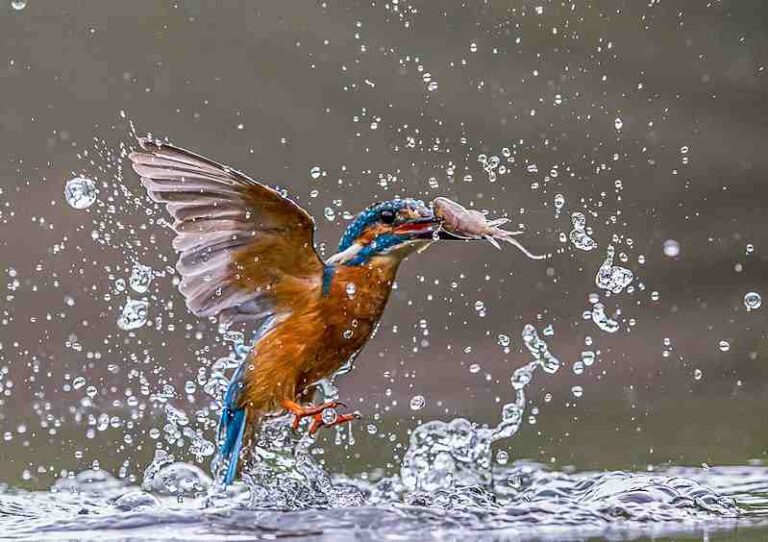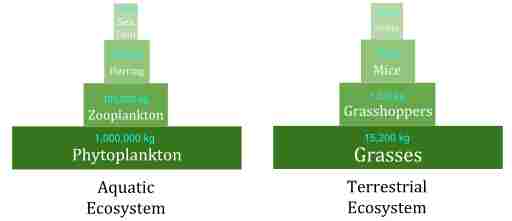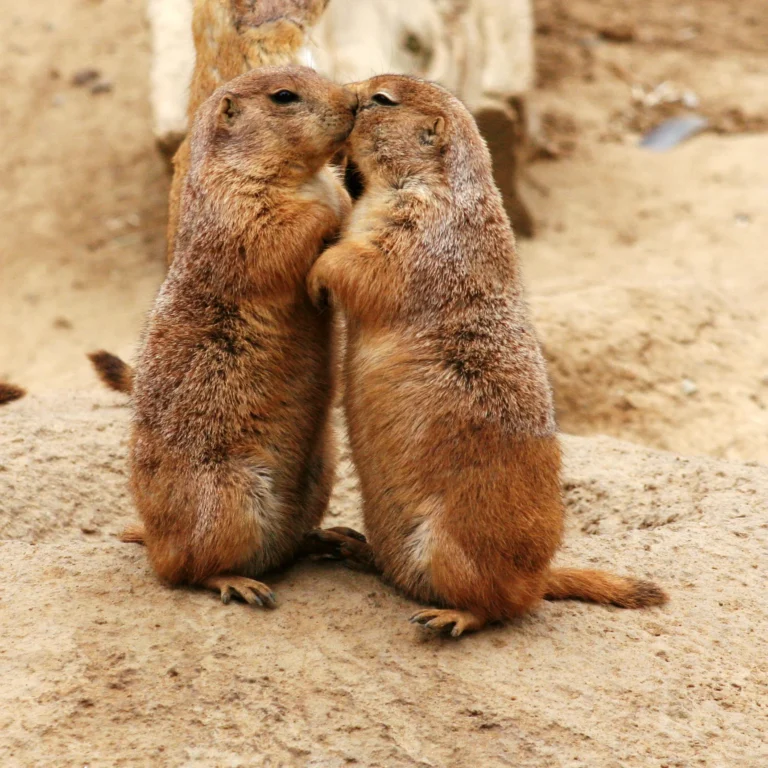Mink Vs Muskrat Size, Weight, Overall Comparison Introduction:
In an envisaged encounter between a mink and a muskrat, two distinct members of the Mustelidae family, we explore the potential dynamics of this confrontation. Distinguished by their morphology, appearance, fur, and diet, minks and muskrats share differences that shape their roles within their ecosystems. This analysis aims to highlight these distinctions and assert that, despite the muskrat often being larger, the mink would likely emerge victorious in a fight due to its agility, intelligence, aggressiveness, and predatory features.
Mink vs Muskrat: Assessing the Likely Victor in a Confrontation
In a hypothetical scenario involving a mink and a muskrat, both members of the Mustelidae family, the outcome of a fight is influenced by distinctions in morphology, appearance, fur, diet, as well as the unique attributes of each species. While muskrats are often larger, the mink’s agility, intelligence, aggressiveness, and predatory features may give it a significant advantage.
I). Morphology, Appearance, Fur, and Diet Differences:
– Minks and muskrats can be differentiated by their overall morphology, appearance, fur, and diet. Muskrats are typically larger, possess a more robust appearance, have coarse fur, and primarily consume aquatic vegetation. In contrast, minks are smaller, sleeker, sport denser fur, and have a carnivorous diet, including fish, frogs, and small mammals.
II). Mink’s Agility and Intelligence:
– In a hypothetical fight, the mink would likely win against a muskrat due to its agility and intelligence. Minks are known for their ability to navigate various terrains with remarkable agility, allowing them to outmaneuver larger opponents. Additionally, their higher intelligence levels contribute to strategic decision-making in confrontational situations.
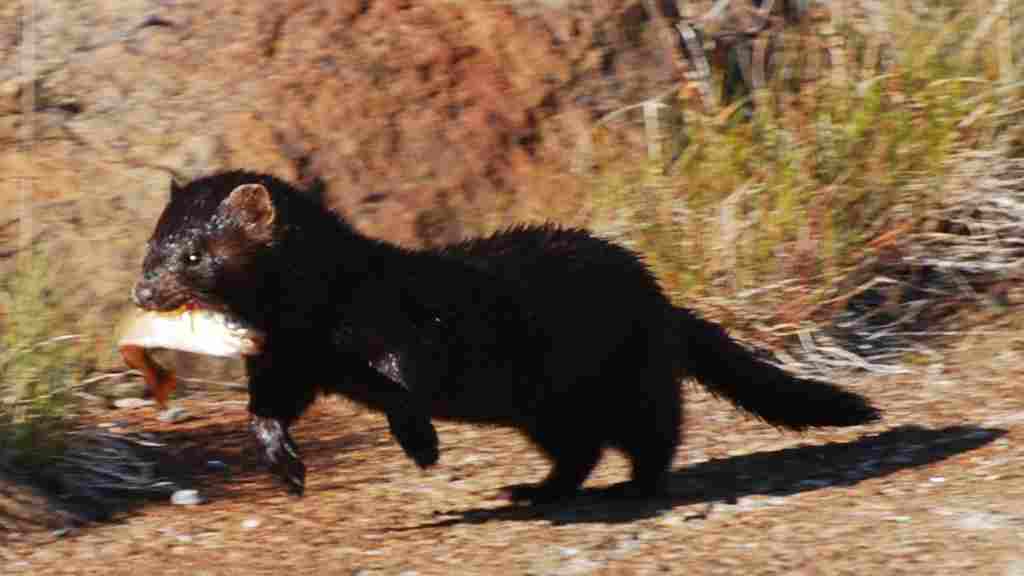
III). Aggressiveness of the Mink:
– Minks are inherently aggressive and territorial, traits that can be advantageous in a fight. When confronted, a mink is likely to exhibit assertive behavior and employ aggressive strategies to establish dominance over a muskrat.
IV). Predatory Features of the Mink:
– The mink’s carnivorous diet reflects its predatory nature, and this includes the ability to effectively hunt and subdue prey. In a confrontation with a muskrat, the mink’s predatory features, such as sharp claws and a strong bite, may contribute to its ability to overpower the larger muskrat.
V). Muskrat’s Size Advantage:
– While muskrats are generally larger, their size advantage may be mitigated by the mink’s agility, intelligence, aggressiveness, and predatory features. In a fight, the mink’s combination of these attributes provides a strategic advantage over the larger muskrat.
VI). Overall Dynamics:
– In this hypothetical scenario, the mink is likely to emerge as the victor in a fight against a muskrat due to its agility, intelligence, aggressiveness, and predatory features. While the muskrat may have a size advantage, the overall dynamics favor the mink in this hypothetical confrontation.
*Details of Comparison
| Criteria | Mink | Muskrat |
| Taxonomy | Order: Carnivora
Family: Mustelidae Genus: Neovison Species: N. vison |
Order: Rodentia
Family: Cricetidae
Genus: Ondatra
Species: O. zibethicus
|
| Appearance | Sleek, dark brown to black fur, streamlined body |
Stout, reddish-brown fur, rat-like appearance, webbed hind feet
|
| Size | 40-71 cm (16-28 inches) excluding tail |
40-63 cm (16-25 inches)
|
| Weight | 0.7-2 kg (1.5-4.4 pounds) |
0.6-1.8 kg (1.3-4 pounds)
|
| Bite Force (PSI) | Strong (prey capture) |
Limited information (herbivores)
|
| Offensive Advantages | Sharp claws, agility for hunting |
Limited offensive capabilities
|
| Defensive Advantages | Agile swimmers, territorial |
Burrow defense, territorial aggression
|
| Speed | Up to 8 km/h (5 mph) in water |
Around 5 km/h (3 mph) in water
|
| Agility | Exceptional, especially in water |
Moderate, proficient in water and burrow construction
|
| Overall Physical Capacity | Streamlined for hunting |
Adapted to semi-aquatic lifestyle
|
| Habitat Preference(s) | Freshwater habitats, broader range for mink |
Freshwater habitats, adaptable to urban areas
|
| Tracks | Distinct with five toes and claw marks |
Five-toed with webbed hind feet, waddle-like pattern
|
| Lifespan | 3-4 years in the wild |
2-3 years in the wild
|
| Feeding | Carnivorous | Herbivorous |
| Intelligence | Higher, especially in hunting |
Moderate, focused on burrow construction and foraging
|
| Social Behavior | Generally solitary |
Can be social, living in family groups
|
| Reproduction | Seasonal breeding, altricial kits |
Year-round breeding, precocial kits
|
| Parental Behavior | Intensive care for altricial kits |
Both parents contribute to protection of precocial kits
|
| Proximity to Human Areas | Avoids direct interaction |
Tolerant, found in urban water bodies
|
| Behavior Toward Humans | Shy, elusive |
Less wary, can be skittish
|
| Danger Posed to Humans | Generally not highly dangerous |
Generally not highly dangerous
|
| Associated Precautions | Maintain a respectful distance, avoid provoking |
Maintain a respectful distance, avoid disturbing burrows
|
| Conservation Status | Population threats from fur trapping and habitat loss |
Generally stable, localized declines possible
|
1. Taxonomy
Mink (Neovison vison):
Kingdom: Animalia
Phylum: Chordata
Class: Mammalia
Order: Carnivora
Family: Mustelidae
Genus: Neovison
Species: N. vison
Muskrat (Ondatra zibethicus):
Kingdom: Animalia
Phylum: Chordata
Class: Mammalia
Order: Rodentia
Family: Cricetidae
Subfamily: Arvicolinae
Tribe: Ondatrini
Genus: Ondatra
Species: O. zibethicus
2. Appearance
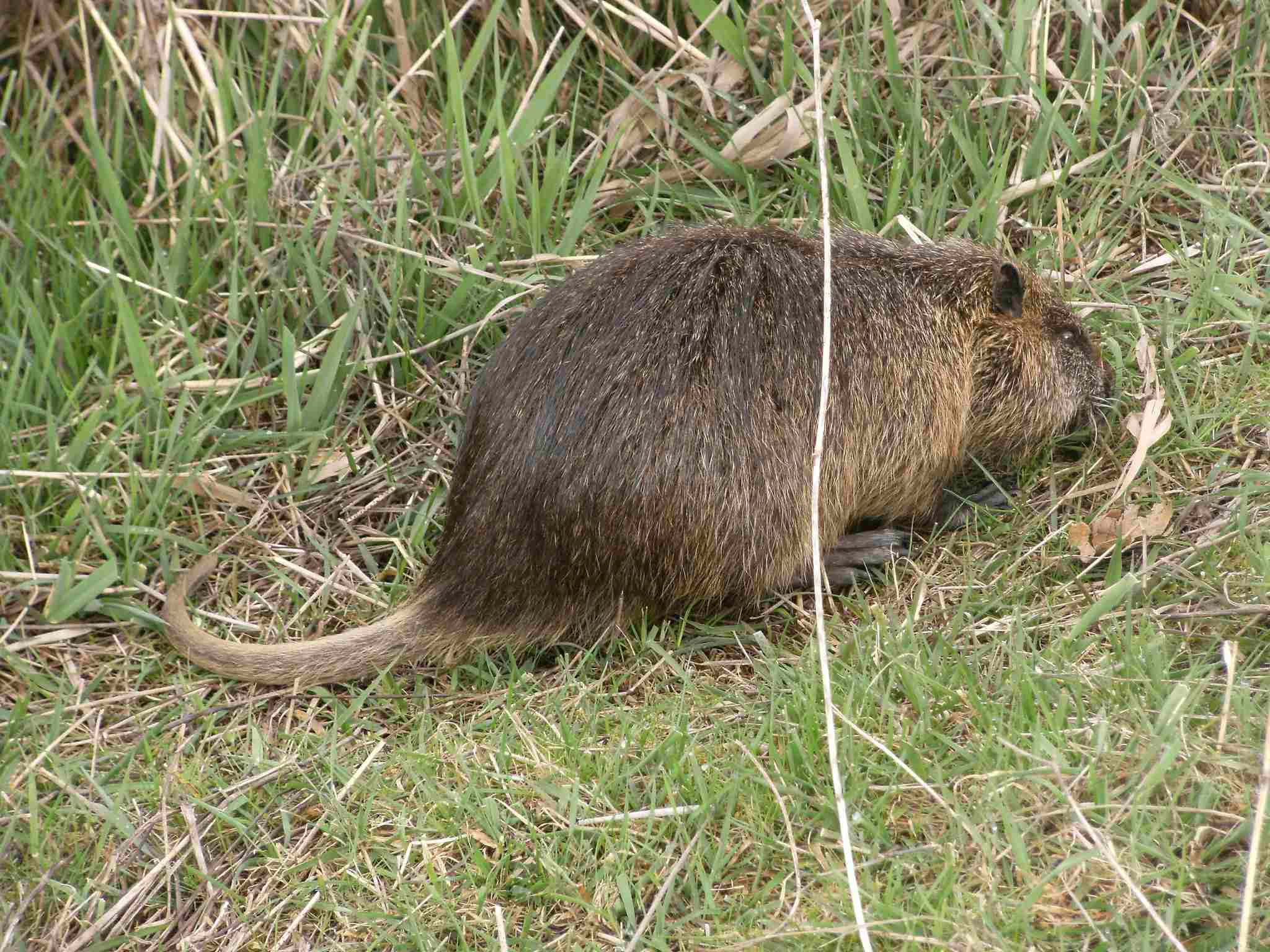
Mink: Slender, sleek body with a dark brown to black fur coat. Small, pointed head and a long, bushy tail. Adapted for semi-aquatic life.
Muskrat: Stout, medium-sized rodent with a waterproof fur coat ranging from dark brown to reddish-brown. Characterized by a rat-like appearance, a scaly tail, and webbed hind feet.
Comparison: While both have brown fur, mink are more streamlined, resembling elongated weasels, whereas muskrats have a robust, rat-like build.
Ecological Implications: The mink’s streamlined form aids in swimming, allowing it to hunt aquatic prey efficiently. Muskrats’ stout build suits their semi-aquatic lifestyle, aiding in burrow construction and swimming.
3. Size
Mink: Length of 40-71 cm (16-28 inches), excluding the tail. Tail length is approximately 15-25 cm (6-10 inches).
Muskrat: Length ranging from 40-63 cm (16-25 inches), with a relatively short tail measuring about 20-27 cm (8-11 inches).
Comparison: Mink and muskrats share a similar body length, but mink have longer tails in proportion to their bodies.
Ecological Implications: Size adaptations are crucial for maneuverability in their respective environments, with mink relying on their longer tails for balance in water.
4. Weight
Mink: Weighs between 0.7 to 2 kg (1.5 to 4.4 pounds).
Muskrat: Typically weighs around 0.6 to 1.8 kg (1.3 to 4 pounds).
Comparison: Mink and muskrats exhibit similar weight ranges, reflecting adaptations to their semi-aquatic lifestyles.
Ecological Implications: Weight influences buoyancy and agility in water, impacting their ability to navigate and hunt for food.
5. Bite Force (PSI)
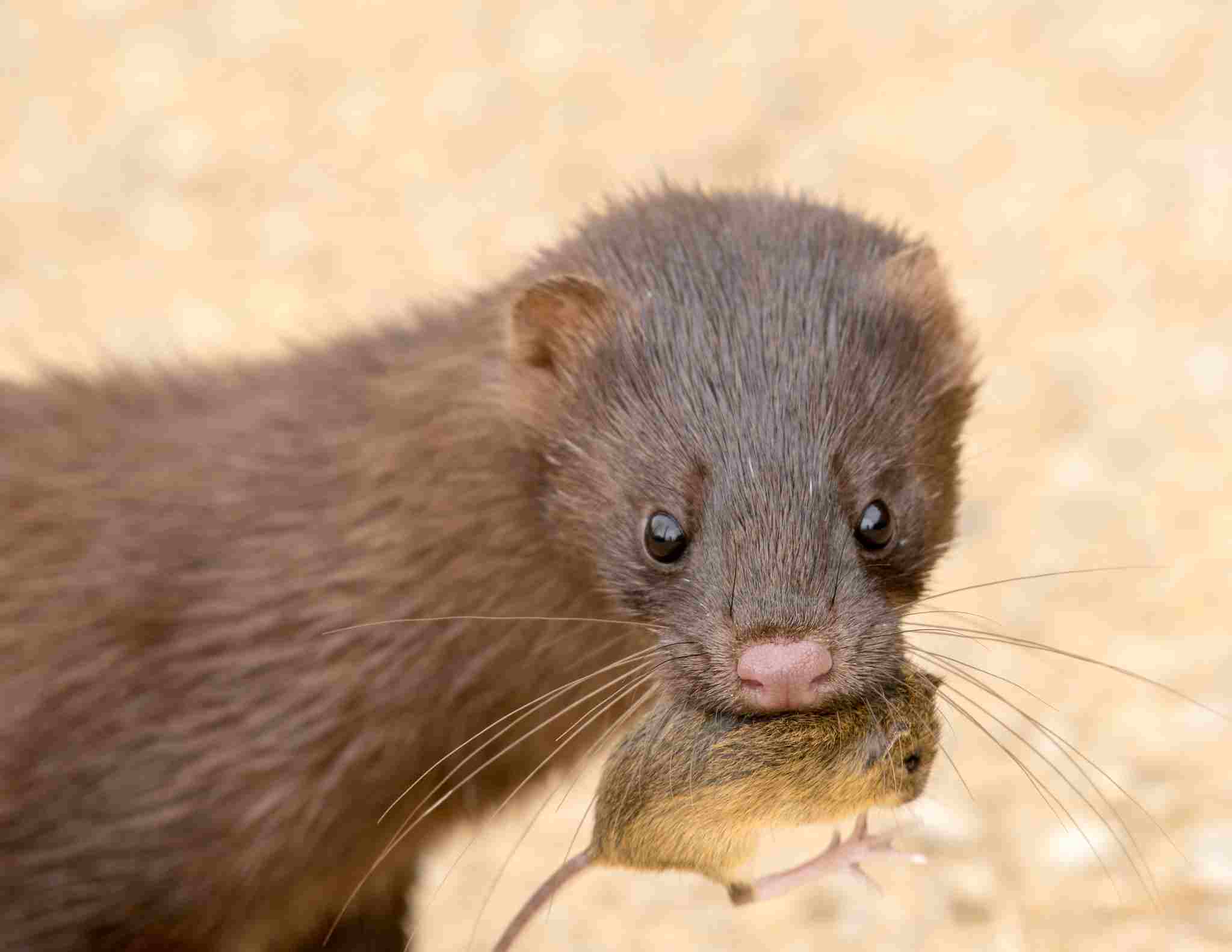
Mink: Estimated bite force is not well-documented but is significant for capturing prey.
Muskrat: Limited information on muskrat bite force, as they rely more on vegetation than actively hunting live prey.
Comparison: Mink likely possess a stronger bite force due to their carnivorous diet and hunting behavior.
Ecological Implications: Bite force relates to hunting strategies and prey selection, influencing the overall ecological balance in their habitats.
6. Physical Offensive Advantages
Mink: Sharp claws and teeth for capturing and subduing prey. Agile and swift in pursuit.
Muskrat: Limited offensive capabilities; relies more on evasion and burrow defense.
Comparison: Mink have specialized physical traits for actively hunting and capturing prey, while muskrats focus on defensive strategies.
Ecological Implications: These offensive adaptations contribute to the overall balance in their ecosystems, with mink playing a more active role in predator-prey dynamics.
7. Physical Defensive Advantages
Mink: Agile swimmers, can escape predators by diving underwater. Territorial behavior helps avoid confrontations.
Muskrat: Well-adapted burrowers; escape predators by diving into their burrows. Slightly aggressive when defending their territory.
Comparison: Mink utilize agility and territorial behavior for defense, while muskrats rely on burrow construction and territorial aggression.
Ecological Implications: These defensive strategies influence the coexistence of mink and muskrats within their shared habitats, minimizing direct competition.
8. Speed (Km/hour or Mile/hour)
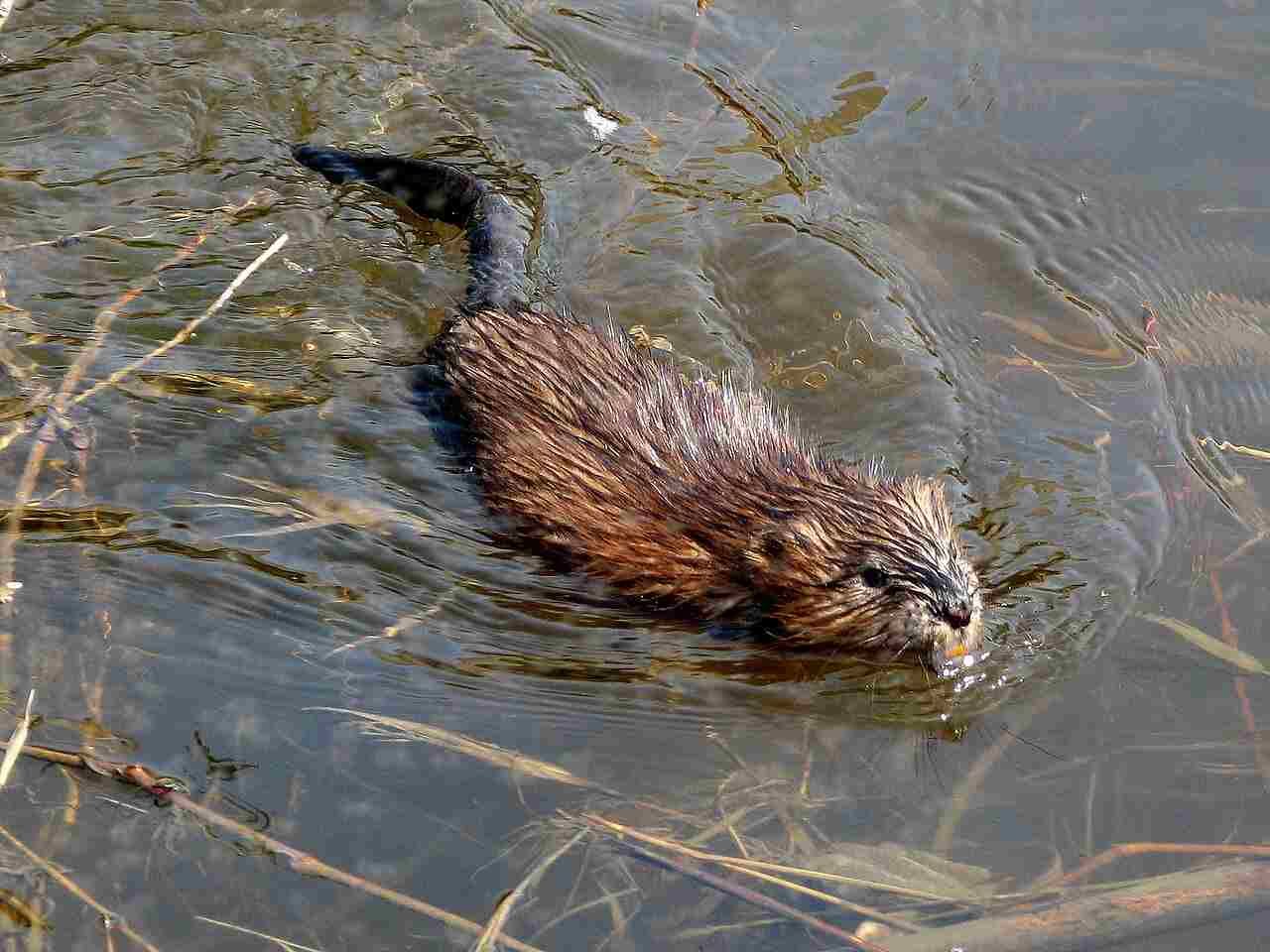
Mink: Agile and fast swimmers, capable of reaching speeds up to 8 km/h (5 mph) in water.
Muskrat: Slower on land but proficient swimmers, achieving speeds of around 5 km/h (3 mph) in water.
Comparison: Mink display higher speeds in the water, reflecting their active hunting behavior.
Ecological Implications: Speed adaptations impact hunting success and escape mechanisms, shaping the dynamics of the food web within their ecosystems.
9. Agility
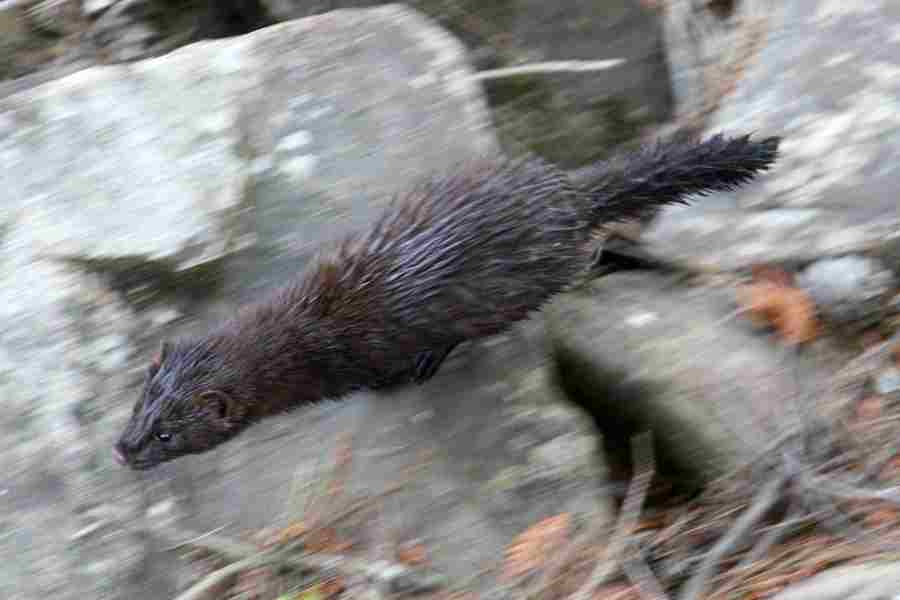
Mink: Exceptional agility, crucial for navigating water environments, climbing, and pursuing prey.
Muskrat: Moderate agility; proficient at maneuvering through water and constructing burrows.
Comparison: Mink exhibit superior agility, especially in water, compared to muskrats.
Ecological Implications: Agility influences their effectiveness in utilizing different niches within their habitats, contributing to ecological diversity.
10. Overall Physical Capacity
Mink: Possesses a high overall physical capacity with a streamlined body, sharp senses, and agility, optimized for hunting and survival.
Muskrat: Well-adapted to a semi-aquatic lifestyle with strong swimming abilities, burrow construction, and territorial behavior.
Comparison: Mink excel in active predation, while muskrats showcase adaptations for a more defensive and herbivorous lifestyle.
Ecological Implications: The diverse physical capacities of mink and muskrats contribute to the overall balance and biodiversity of their respective ecosystems.
11. Habitat Preference(s)
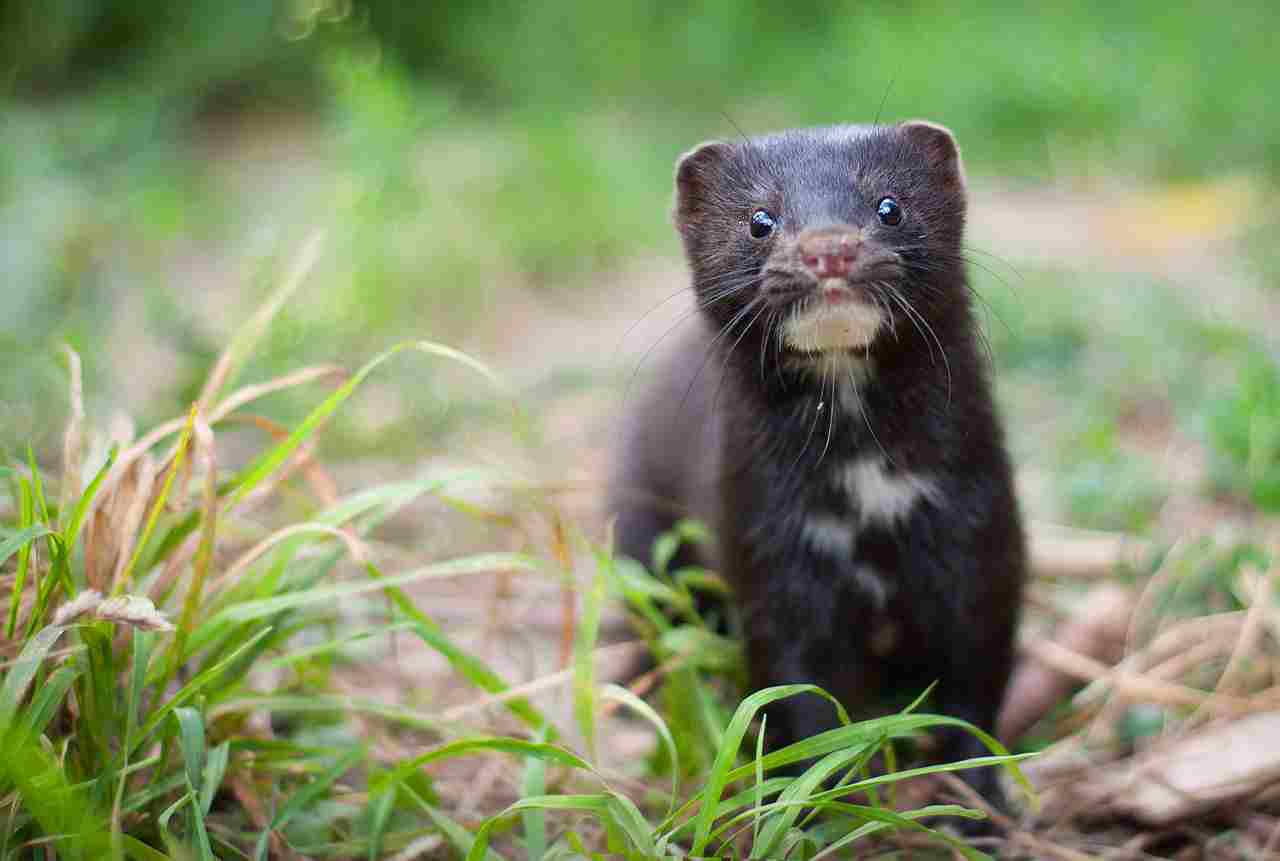
Mink: Primarily found near freshwater habitats such as rivers, lakes, and wetlands. Establishes dens in bank burrows or hollow trees.
Muskrat: Inhabits freshwater habitats, preferring marshes, ponds, and slow-moving streams. Constructs burrows in banks or builds lodges.
Comparison: Both share a preference for freshwater environments, but mink tend to inhabit a broader range of habitats.
Ecological Implications: Habitat preferences influence resource utilization and competition, contributing to the overall health of aquatic ecosystems.
12. Tracks
Mink: Distinct tracks with five toes and claw marks. Stride length varies based on gait, reflecting their agile movements.
Muskrat: Five-toed tracks with webbed hind feet, often showing a waddle-like pattern due to their short legs.
Comparison: The tracks of mink and muskrats reflect their different physical adaptations and modes of movement.
Ecological Implications: Tracking studies aid in understanding their movement patterns, territorial behavior, and potential ecological impacts.
13. Lifespan
Mink: Typically lives 3-4 years in the wild, although they may reach up to 10 years in captivity.
Muskrat: Has an average lifespan of 2-3 years in the wild.
Comparison: Both species exhibit relatively short lifespans, influenced by predation, environmental factors, and reproductive strategies.
Ecological Implications: Short lifespans contribute to population dynamics, affecting predator-prey relationships and overall ecosystem stability.
14. Mode of Feeding
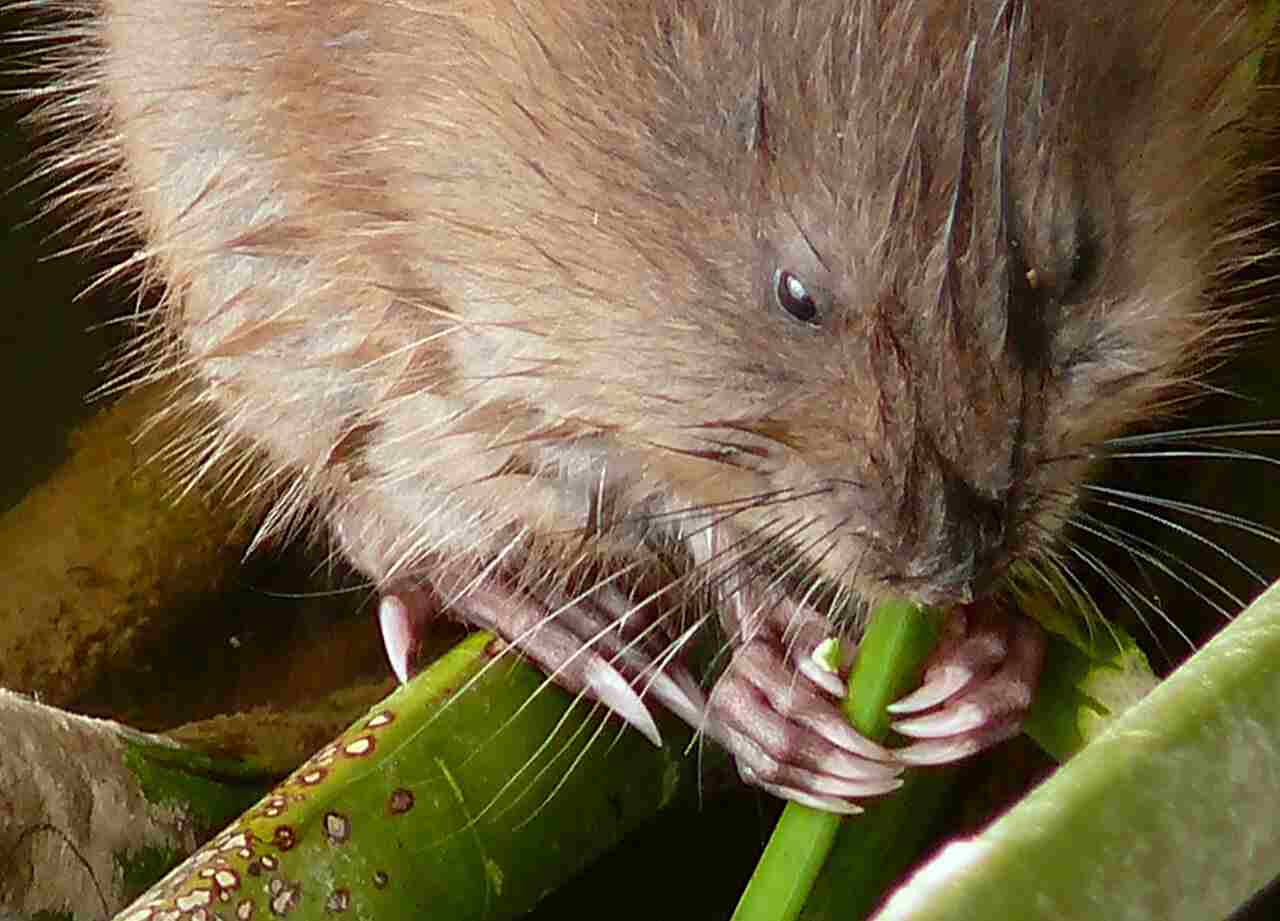
Mink: Carnivorous diet, preying on fish, amphibians, birds, and small mammals. Effective hunters both in water and on land.
Muskrat: Herbivorous diet, primarily consuming aquatic vegetation like cattails, bulrushes, and roots.
Comparison: Mink showcase a predatory feeding mode, while muskrats are herbivores relying on aquatic plant resources.
Ecological Implications: Their distinct feeding modes contribute to the regulation of prey populations and vegetation balance within their ecosystems.
15. Intelligence
Mink: Display high intelligence, particularly in hunting strategies and adapting to various environments.
Muskrat: Exhibits moderate intelligence, with a focus on burrow construction, territorial behavior, and foraging.
Comparison: Mink demonstrate a higher level of problem-solving ability, especially in the context of hunting.
Ecological Implications: Intelligence influences adaptation to changing environmental conditions, impacting resource utilization and survival.
16. Social Behavior
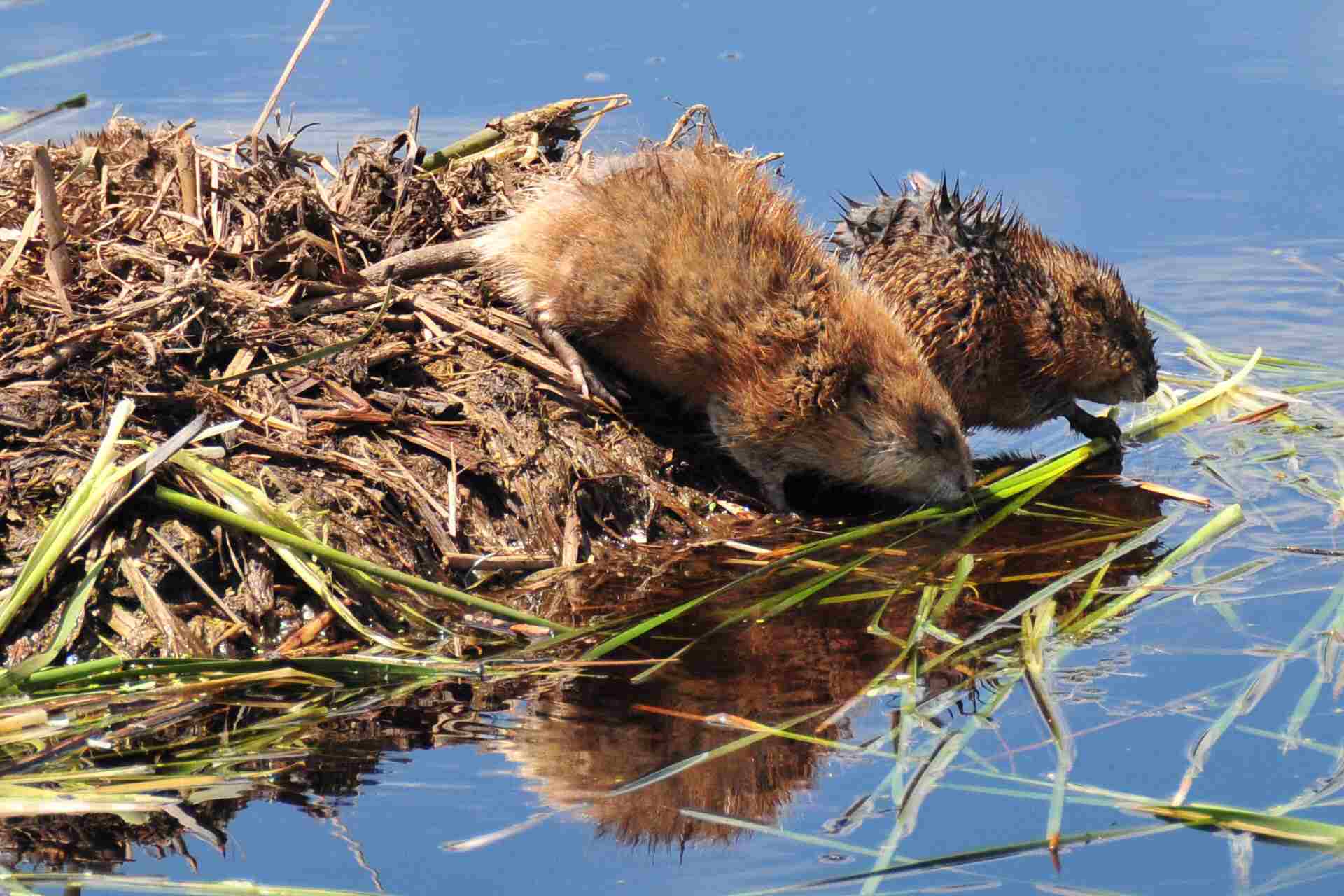
Mink: Generally solitary, with limited social interactions. Territorial and may exhibit aggression towards intruders.
Muskrat: Can be social, living in family groups. Defends territories and may show aggression during the breeding season.
Comparison: Mink are more solitary, while muskrats exhibit some social behaviors, particularly in family units.
Ecological Implications: Social dynamics affect population structure, resource distribution, and overall ecosystem balance.
17. Mode of Reproduction
Mink: Seasonal breeders, typically giving birth to a litter of 3-6 kits. Kits are born blind and helpless, requiring maternal care.
Muskrat: Breed throughout the year, with a peak in spring and summer. Average litter size ranges from 2-11 kits. Kits are precocial and can swim soon after birth.
Comparison: Mink have a more defined breeding season, and their kits are altricial, requiring more maternal care compared to the precocial muskrat kits.
Ecological Implications: Reproductive strategies influence population dynamics, impacting prey-predator relationships and community structure.
18. Parental Behavior
Mink: Females invest significant parental care, nursing and protecting altricial kits until they are old enough to hunt. Males may play a role in providing food.
Muskrat: Females provide care to precocial kits, nursing and protecting them within the family unit. Both parents contribute to kit protection.
Comparison: While both exhibit parental care, mink kits require more intensive care due to their altricial nature.
Ecological Implications: Parental behavior influences juvenile survival rates and contributes to the overall stability of their populations.
19. Proximity to Human-Inhabited Areas
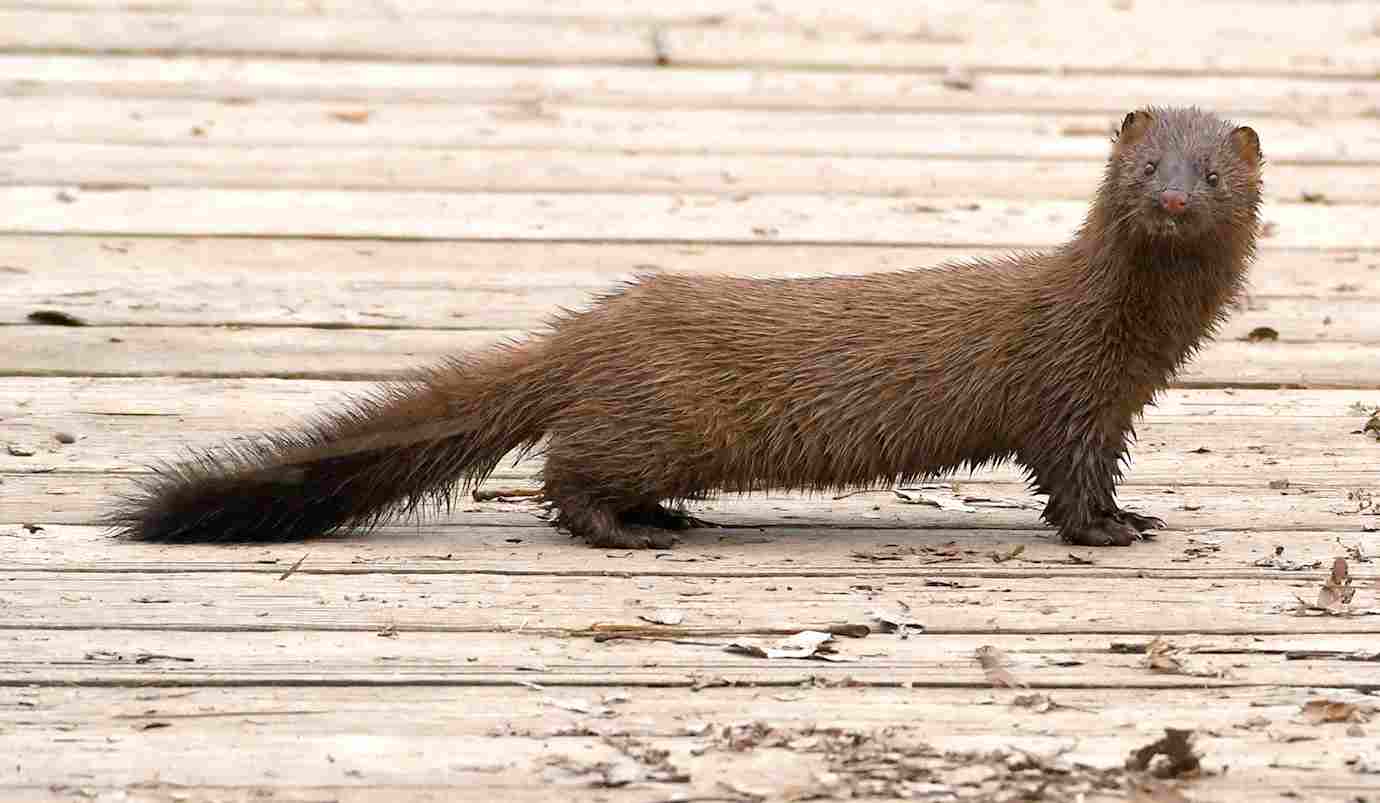
Mink: May be found near water bodies close to human settlements but generally avoid direct interaction with humans.
Muskrat: Tolerant of human-altered environments, often found in ponds, ditches, and urban water bodies.
Comparison: Muskrats display more adaptability to human-altered landscapes compared to mink.
Ecological Implications: The ability to coexist with human activities affects their exposure to anthropogenic influences and potential conflicts.
20. Behavior Toward Humans
Mink: Generally shy and elusive, avoiding human contact. May show aggression if cornered.
Muskrat: Tends to be less wary of humans, especially in urban areas, but can be skittish.
Comparison: Mink are more reclusive, while muskrats may tolerate closer proximity to human activities.
Ecological Implications: Behavioral responses to humans influence their susceptibility to habitat alteration and potential threats.
21. Danger Posed to Humans
Mink: Rarely pose a threat to humans; bites may occur if cornered or threatened.
Muskrat: Generally not dangerous to humans, but can be aggressive if approached or handled.
Comparison: Both species are not considered highly dangerous to humans, with minimal risk of aggression.
Ecological Implications: Low danger to humans contributes to a more harmonious coexistence in shared habitats, reducing the likelihood of conflict.
22. Associated Precautions
Mink: To avoid potential conflicts, it is advisable to observe from a distance and refrain from cornering or provoking them. Secure food waste near water bodies to minimize attraction.
Muskrat: If encountered near water bodies, it’s best to observe from a distance. Avoid interfering with burrows to prevent stress to individuals.
Comparison: Precautions for both species involve maintaining a respectful distance and minimizing disturbance to their habitats.
Ecological Implications: Responsible behavior around these animals helps preserve their natural behaviors and reduces stress on the individuals, contributing to a healthier ecosystem.
23. Conservation Status
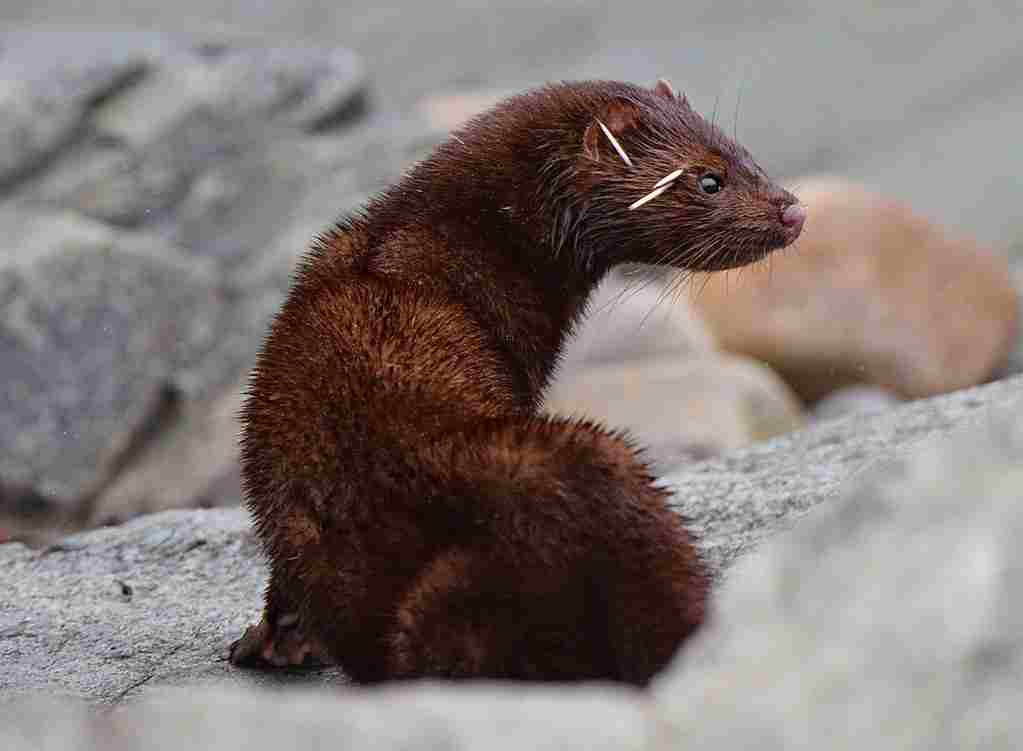
Mink: Populations can face threats from habitat loss, pollution, and fur trapping. Conservation status varies regionally.
Muskrat: Generally, populations are stable, but localized declines can occur due to habitat alteration or water pollution.
Comparison: Conservation concerns vary; mink may face more significant threats due to their fur and habitat-related issues.
Ecological Implications: Conservation efforts are essential to maintain biodiversity and ecological balance, especially for species facing threats.
Summary of Comparison
Taxonomy:
Mink: Order Carnivora, Family Mustelidae, Genus Neovison, Species N. vison
Muskrat: Order Rodentia, Family Cricetidae, Genus Ondatra, Species O. zibethicus
Appearance:
Mink: Sleek, dark brown to black fur, streamlined body.
Muskrat: Stout, reddish-brown fur, rat-like appearance, webbed hind feet.
Size:
Mink: 40-71 cm (16-28 inches) excluding tail.
Muskrat: 40-63 cm (16-25 inches).
Weight:
Mink: 0.7-2 kg (1.5-4.4 pounds).
Muskrat: 0.6-1.8 kg (1.3-4 pounds).
Bite Force (PSI):
Mink: Strong for prey capture.
Muskrat: Limited information, as herbivores.
Physical Offensive Advantages:
Mink: Sharp claws, agility for hunting.
Muskrat: Limited offensive capabilities.
Physical Defensive Advantages:
Mink: Agile swimmers, territorial.
Muskrat: Burrow defense, territorial aggression.
Speed:
Mink: Up to 8 km/h (5 mph) in water.
Muskrat: Around 5 km/h (3 mph) in water.
Agility:
Mink: Exceptional agility, especially in water.
Muskrat: Moderate agility, proficient in water and burrow construction.
Overall Physical Capacity:
Mink: Streamlined for hunting.
Muskrat: Adapted to semi-aquatic lifestyle.
Habitat Preference(s):
Both prefer freshwater habitats, but mink may inhabit a broader range.
Tracks:
Mink: Distinct with five toes and claw marks.
Muskrat: Five-toed with webbed hind feet, waddle-like pattern.
Lifespan:
Mink: 3-4 years in the wild.
Muskrat: 2-3 years in the wild.
Mode of Feeding:
Mink: Carnivorous.
Muskrat: Herbivorous.
Intelligence:
Mink: Higher intelligence, especially in hunting.
Muskrat: Moderate intelligence, focused on burrow construction and foraging.
Social Behavior:
Mink: Generally solitary.
Muskrat: Can be social, living in family groups.
Mode of Reproduction:
Mink: Seasonal breeding, altricial kits.
Muskrat: Year-round breeding, precocial kits.
Parental Behavior:
Mink: Intensive care for altricial kits.
Muskrat: Both parents contribute to protection of precocial kits.
Proximity to Human-Inhabited Areas:
Mink: Avoids direct interaction.
Muskrat: Tolerant, found in urban water bodies.
Behavior Toward Humans:
Mink: Shy, elusive.
Muskrat: Less wary, can be skittish.
Danger Posed to Humans:
Both species are generally not considered highly dangerous.
Associated Precautions:
Maintain a respectful distance and minimize disturbance to habitats for both.
Conservation Status:
Mink may face higher threats due to fur trapping and habitat loss.
Muskrat populations generally stable but can decline locally.
Conclusion
I. Similarities
Both mink and muskrat play crucial roles in aquatic ecosystems.
Share a preference for freshwater habitats.
Exhibit territorial behavior for resource protection.
II. Differences
Mink are carnivores with a streamlined build, while muskrats are herbivores with a rat-like appearance.
Mink have altricial kits requiring intensive maternal care, whereas muskrats have precocial kits.
Mink may face higher conservation threats, including fur trapping.
